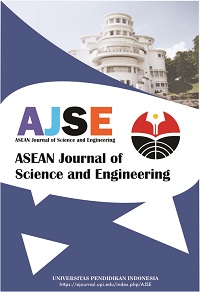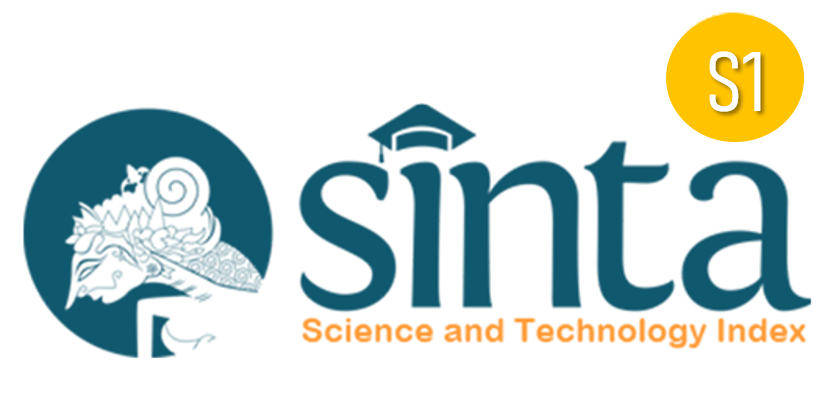Characterization, Acidifying, and Antibacterial Activity of Lactic Acid Bacteria Against Spoilage Strains Present in Chicken Meat
Abstract
Keywords
Full Text:
PDFReferences
Al-Joda, B. M. S., and Jasim, A. H. (2021). Biochemical testing revision for identification several kinds of bacteria. Journal of University of Babylon for Pure and Applied Sciences, 29(2), 168-176.
Atlabachew, T., and Mamo, J. (2021). Microbiological quality of meat and swabs from contact surface in butcher shops in Debre Berhan, Ethiopia. Journal of Food Quality, 2021, 1-11.
Balouiri, M., Sadiki, M., and Ibnsouda, S. K. (2016). Methods for in vitro evaluating antimicrobial activity: A review. Journal of Pharmaceutical Analysis, 6(2), 71-79.
Choukri, S., Dahaieh, N., Ijoub, R., Nehiri, M., Ettouil, A., Atfaoui, K., Mouniane, Y., Rokrni, Y., Ouhssine, M. (2022). Phenotypic identification of five homolactic-type lactic strains, isolated from three different barley-based biotopes. Journal of Xi’an Shiyou University, Natural Science Edition. 18, 1111-1115.
Delves-Broughton, J. (1990). Nisin and its uses as a food preservative. Food Technology, 44, 100-117.
Dimassi, O., Iskandarani, Y., Afram, M., Akiki, R., and Rached, M. (2020). Production and physicochemical properties of labneh anbaris, a traditional fermented cheese like product, in Lebanon. International Journal of Environment, Agriculture and Biotechnology, 5(3), 509-516.
Eiteman, M. A., and Ramalingam, S. (2015). Microbial production of lactic acid. Biotechnology Letters, 37, 955-972.
El Moualdi, L., Labioui, H., Boushama, L., Benzakour, A., Ouhssine, M., and Yachioui, E. M. (2008). Activité bactéricide d’une souche de Lactococcus lactis subsp. cremoris. Bull Soc Pharm Bordeaux, 147, 7-18.
Endale, B. G., and Hailay, G. (2013). Assessment of bacteriological quality of meat contact surfaces in selected butcher shops of Mekelle city, Ethiopia. Journal of Environmental and Occupational Science, 2(2), 61-66.
Fosse, J., Cappelier, J. M., Laroche, M., Fradin, N., Giraudet, K., and Magras, C. (2006). Viandes bovines: une analyse des dangers biologiques pour le consommateur appliquée à l’abattoir. Rencontre Recherche Ruminants, 13, 411-414.
Gagnon, M., Ouamba, A. J., LaPointe, G., Chouinard, P. Y., and Roy, D. (2020). Prevalence and abundance of lactic acid bacteria in raw milk associated with forage types in dairy cow feeding. Journal of Dairy Science, 103(7), 5931-5946.
Girma, A., and Aemiro, A. (2021). Antibacterial activity of lactic acid bacteria isolated from fermented Ethiopian traditional dairy products against food spoilage and pathogenic bacterial strains. Journal of Food Quality, 2021, 1-10.
Gomes, B., Pena, P., Cervantes, R., Dias, M., and Viegas, C. (2022). Microbial contamination of bedding material: One health in poultry production. International Journal of Environmental Research and Public Health, 19(24), 16508.
Gwida, M., Hotzel, H., Geue, L., Tomaso, H. (2014). Occurrence of Enterobacteriaceae in raw meat and in human samples from Egyptian retail sellers. International Scholarly Research Notices, 2014, 565671.
Hamdaoui, N., Rokni, Y., Asehraou, A., Mouncif, M., Mennane, Z., Omari, A., Sellam, A., Hammouti, B., and Meziane, M. (2023) Technological aptitude and sensitivity of lactic acid bacteria leuconostoc isolated from raw milk of cows: From step-by-step experimental procedure to the results. Indonesian Journal of Science and Technology 8(2), 157-170.
Kabrite, S., Bou-Mitri, C., Fares, J. E. H., Hassan, H. F., and Boumosleh, J. M. (2019). Identification and dietary exposure assessment of tetracycline and penicillin residues in fluid milk, yogurt, and labneh: A cross-sectional study in Lebanon. Veterinary World, 12(4), 527.
Magno, I. T., Esmail, R. P., Lim, M. S. S., Padua, J. N. J. D., Reyes, K. L., Tugom, L. A. G., Valdez, A. G., and Abusama, H. P. (2022). Antibacterial effect of calabash (crescentia cujete) leaf and fruit extract on preservation of lettuce (lactuca sativa) leaves with escherichia coli. ASEAN Journal of Science and Engineering, 2(1), 91-94.
Mourad, K., and Nour-Eddine, K. (2006). Physicochemical and microbiological study of “shmen”, a traditional butter made from camel milk in the Sahara (Algeria): isolation and identification of lactic acid bacteria and yeasts. Grasas y Aceites, 57(2), 198-204.
Nizori, A., Sukendra, A., and Mursyid, S. (2019, November). Antimicrobial activity of lactic acid bacteria isolated from fermented durian flesh (tempoyak) against pathogenic and spoilage bacteria during storage. IOP Conference Series: Earth and Environmental Science, 347(1), 012053.
Ouhssine, K., Ouhssine, M., and Elyachioui, M. (2007). L’application des déchets traités de l’algue Gelidium sesquipédale dans la culture du Maïs. Afrique Science: Revue Internationale des Sciences et Technologie, 3(2), 259-270.
Pulsani, S. R., Rao, D. R., and Sunki, G.R. (1979). Antimicrobial Activity of lactic cultures: Partial purification and characterization of antimicrobial compounds produced by Streptococcus thermophillus. Journal Food Sciences, 44, 575-578.
Rahayu, Y.S. (2019). Isolation and identification of hydrocarbon degradation bacteria and phosphate solubilizing bacteria in oil contaminated soil in Bojonegoro, East Java, Indonesia. Indonesian Journal of Science and Technology, 4(1), 134-147.
Rodríguez, H., Curiel, J. A., Landete, J. M., de las Rivas, B., de Felipe, F. L., Gómez-Cordovés, C., and Muñoz, R. (2009). Food phenolics and lactic acid bacteria. International Journal of Food Microbiology, 132(2-3), 79-90.
Rokni, Y., Abouloifa, H., Bellaouchi, R., Gaamouche, S., Mchiouer, K., Hasnaoui, I., Lamzira, Z., Ghabbour, N., and Asehraou, A. (2017). Technological process of fermented olive. Arabian Journal of Chemical and Environmental Research, 4, 63-91
Sambegoro, P., Fitriyanti, M., Budiman, B. A., Kamarisima, K., Baliwangi, S. W. A., Alverian, C., Bagherzadeh, S., Narsimhan, G., Aditiawati, P., and Nurprasetio, I. P. (2021). Bacterial cell inactivation using a single-frequency batch-type ultrasound device. Indonesian Journal of Science and Technology, 6(1), 65-80.
Sari, D. P., Yuniar, S., Fadillah, S. A. N., Mutiarani, A., and Kusumawaty, D. (2022). The effectiveness of mugwort leaf extract and gotu kola leaf extract against acne bacterial activity. ASEAN Journal of Science and Engineering, 2(3), 247-254.
Sari, E., Nugroho, A. P., Retnaningrum, E., and Prijambada, I. D. (2023). Literature review and experiment: Diversity of bacteria in forest, revegetated post-mining land, and active tin mining with a metagenomic approach. Indonesian Journal of Science and Technology, 8(1), 19-48.
Schillinger, U., and L cke, F. K. (1989). Antibacterial activity of Lactobacillus sake isolated from meat. Applied and Environmental Microbiology, 55(8), 1901-1906.
Theocharidi, N. A., Balta, I., Houhoula, D., Tsantes, A. G., Lalliotis, G. P., Polydera, A. C., and Halvatsiotis, P. (2022). High prevalence of Klebsiella pneumoniae in Greek meat products: Detection of virulence and antimicrobial resistance genes by molecular techniques. Foods, 11(5), 708.
Valgas, C., Souza, S. M. D., Smânia, E. F., and Smânia Jr, A. (2007). Screening methods to determine antibacterial activity of natural products. Brazilian journal of microbiology, 38, 369-380.
Wang, Y., Wu, J., Lv, M., Shao, Z., Hungwe, M., Wang, J., and Geng, W. (2021). Metabolism characteristics of lactic acid bacteria and the expanding applications in food industry. Frontiers in Bioengineering and Biotechnology, 9, 612285.
Wardhana, DK., Haskito, A. E. P., Purnama, M. T. E., Safitri, D. A., and Annisa S. (2021). Detection of microbial contamination in chicken meat from local markets in Surabaya, East Java, Indonesia. Veterinary World, 14(12), 3138-3143.
DOI: https://doi.org/10.17509/ajse.v3i3.60380
Refbacks
- There are currently no refbacks.
Copyright (c) 2023 Universitas Pendidikan Indonesia

This work is licensed under a Creative Commons Attribution-ShareAlike 4.0 International License.












